
About UsThe Numismatic Bibliomania Society is a non-profit organization promoting numismatic literature. For more information please see our web site at coinbooks.org SubscriptionsThose wishing to become new E-Sylum subscribers (or wishing to Unsubscribe) can go to the following web page link MembershipThere is a membership application available on the web site Membership Application To join, print the application and return it with your check to the address printed on the application. Membership is only $15 to addresses in the U.S., $20 for First Class mail, and $25 elsewhere. For those without web access, write to: David M. Sundman, Treasurer AsylumFor Asylum mailing address changes and other membership questions, contact David at this email address: dsundman@LittletonCoin.com SubmissionsTo submit items for publication in The E-Sylum, just Reply to this message, or write to the Editor at this address: whomren@gmail.com
BUY THE BOOK BEFORE THE COIN |
- WAYNE'S WORDS: THE E-SYLUM NOVEMBER 3, 2013
- LAKE BOOKS SALE #116 PRICED REALIZED AVAILABLE
- FREEMAN & SEAR NUMISMATIC BOOK E-AUCTION CLOSES NOVEMBER 5, 2013
- LITERATURE DEALERS AT THE NOVEMBER 2013 BALTIMORE SHOW
- NEWMAN HARDCOVER SUBSCRIPTIONS STILL AVAILABLE
- BOOK REVIEW: A GUIDE BOOK OF CIVIL WAR TOKENS
- BOOK REVIEW: MONNAIE ET JETONS DE L’INDOCHINE FRANÇAISE
- BOOK REVIEW: FRACTIONAL MONEY BY CAROTHERS
- NOTES FROM E-SYLUM READERS: NOVEMBER 3, 2013
- THE GILCREASE MUSEUM, TULSA, OK
- HARVEY STACK REMEMBERS GEORGE F. SCANLON
- THE MOUNT RUSHMORE FIVE-OUNCE SILVER COIN
- QUERY: WHERE DID A THOUSAND 1792 HALF DISMES GO?
- COLLECTOR MARY B. BLANKENBUEHLER INFORMATION SOUGHT
- IMAGES OF HAROLD NEWLIN AND ROBERT COULTON DAVIS SOUGHT
- DANIEL W. VALENTINE MEDAL CENSUS INFORMATION SOUGHT
- 1892 LIBERTY SEATED COIN GLASS FOLLOW-UP
- MINT PRESS NO. 1 MAKES NEVADA SESQUICENTENNIAL MEDALS
- HOWARD BERLIN VISITS SLOVENIAN NUMISMATIC COLLECTIONS
- KÜNKER SALE NO 242 OF HISTORICAL MEDALS
- MORE ON THE SAINT ELIGIUS MEDAL
- ERIC NEWMAN PART III TO FEATURE WORLD COINS
- THE NATIONAL NUMISMATIC COLLECTION RICHARD DOTY FUND
- NORWEGIAN MAN'S BITCOIN WINDFALL
- ANNIE OAKLEY'S CHARM BRACELET
- FEATURED WEB SITE: SILVER INGOT BLOG
Click here to access the complete archive
To comment or submit articles, reply to whomren@gmail.com
WAYNE'S WORDS: THE E-SYLUM NOVEMBER 3, 2013

New subscribers this week include Angie Moore. Welcome aboard! We have 1,681 email subscribers, plus 248 followers on Facebook.
This week we open with an update from Fred Lake and information about an online sale of numismatic literature. Next up are notes about dealers at this week's Baltimore show, and three book reviews.
Other topics include Peace medals at the Gilcrease Museum, collectors George Scanlon and Mary Blankenbuehler, Carson City Mint Press No. 1, silver ingots, and the coin cabinet of the National Museum of Slovenia.
To learn more about Liberty Seated Coin glass, the International Congress on Medieval Studies, coinage of the Habsburgs, grading reconsideration, a hoard of 1792 half dismes, the rare coin gumball machine and the largest nose depicted on a coin, read on. Have a great week, everyone!
Wayne Homren
Editor, The E-Sylum
LAKE BOOKS SALE #116 PRICED REALIZED AVAILABLE
The Prices Realized List for Lake Books' mail-bid auction sale of numismatic literature #116 which closed on Tuesday, October 29, 2013 is now posted on our web site at http://www.lakebooks.com/current.html The sale was highlighted by a long run of New Netherlands catalogs and results were well over estimates with the very earliest sales bringing prices in the $100 to $140 range. Also featured were over forty of the Bowers & Merena hardbound sale catalogs which brought strong prices.
Make sure that you "refresh" your browser as all of the links on the "Current" page and the "Past Sale" page are working.
Delivery of lots to our successful bidders will begin next week with invoices to follow. Many thanks to our bidders !
Fred
Lake Books
PMB 118
6822 22nd Ave N
St. Petersburg, FL 33710
727-343-8055 Fax: 727-381-6822
FREEMAN & SEAR NUMISMATIC BOOK E-AUCTION CLOSES NOVEMBER 5, 2013
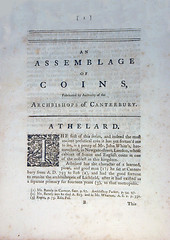 Freeman & Sear is pleased to announce a special book e-auction, running from now until November 5th. You may view and bid on lots at:
www.freemanandsear.com/books
.
Freeman & Sear is pleased to announce a special book e-auction, running from now until November 5th. You may view and bid on lots at:
www.freemanandsear.com/books
.
Our current sale comprises 321 individual and group lots of numismatic literature on the coins of ancient Greece and Rome, the Bible, medieval and early modern Europe, India, and America as well as books on ancient art, history, and numismatic collecting. Among the volumes are essential works including Spink's Roman Imperial Coinage, Alberto Banti¹s Corpus Nummorum and Grandi Bronzi Imperiali, issues of the American Numismatic Society's Numismatic Notes and Monographs, and a large offering of Sylloges of Coins of the British Isles.
Some not-to-be-missed highlights of the collection being offered are a complete, fine edition of Ernest Babelon's Traité des Monnaies Grecques et Romaines (lot 16); a complete, very fine Forni reprint of the Catalogue of the Greek Coins in the British Museum (lot 68); Van Arsdell's out-of-print and highly demanded Celtic Coinage of Britain (lot 39); a Guy Genard reprint of Engel and Lehr's rare but definitive tome, Numismatique de L'Alsace (lot 163); and several works on the coinage of Spain and the Visigoths (lots 269-272). Also of note are several antiquarian books: Wilhelm Ernst Tenzel's 1705 Saxonia Numismatica Lineae Albertinae and Saxonia Numismatica Lineae Ernestinae, with elaborate and wonderful engraved frontispieces (lots 129 and 130); and Samuel Pegge's 1772 Assemblage of Coins Fabricated by Authority of the Archbishops of Canterbury (lot 128).
Whether beginning to put together your numismatic library with standard classics or searching for that elusive volume to complete your collection, you may find just what you are looking for in our book auction. Please direct any questions to rhiannon@freemanandsear.com .
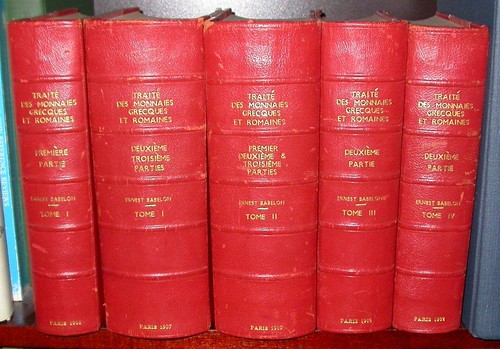
TABLE OF CONTENTS
Ancient Coins: Lots 1-20
Ancient Art: 21-33
Ancient Greek Coins: 34-68
Ancient Roman Coins: 69-101
Anglo-Saxon/English Coins: 102-127
Antiquarian Numismatic Titles: 128-130
Biblical Era Coins: 131-134
Series: Corpus Nummorum Romanorum: 135-146
Eastern European Coins: 147-158
French Coins: 159-172
General / Miscellaneous Numismatics: 173-185
Germanic Coins: 186-219
Series: Grandi Bronzi Imperiali: 220-225
Historic Catalogues: 226-234
Italian Coins: 235-240
Medieval General & Miscellaneous: 241-244
Numismatic Journals: 245-249
Series: Numismatic Notes and Monographs: 250-256
Other European Coins: 257-260
Series: Roman Imperial Coinage: 261-268
Spanish Coins: 269-272
Sylloges: 273-321
Best Wishes,
Rhiannon Knol
Freeman & Sear
Santa Monica, CA
(310) 450-9755
LITERATURE DEALERS AT THE NOVEMBER 2013 BALTIMORE SHOW
Charlie Davis writes:
I will have my usual tables at the Whitman Baltimore show November 7-10. In addition to retail stock, I will be bringing a selection of lots from our November 16 auction for preview. Any lot will be brought on request.
Charles Davis
Box 547
Wenham Massachusetts 01984
www.Numisbook.com
To read the earlier E-Sylum article, see: AUTHORS MERCANTI AND MOY AT BALTIMORE EXPO NOVEMBER 2013 (www.coinbooks.org/esylum_v16n43a16.html)
For more information on the show, see: Baltimore Winter Expo (Nov 7-10, 2013) (expo.whitman.com/baltimore-winter-expo/)
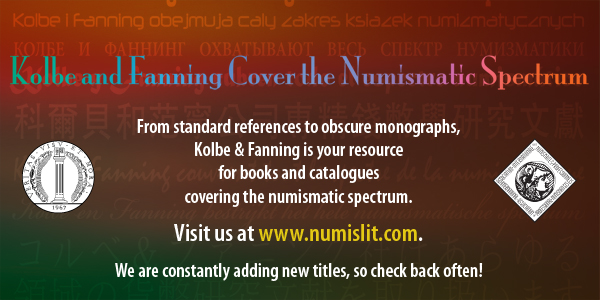
NEWMAN HARDCOVER SUBSCRIPTIONS STILL AVAILABLE
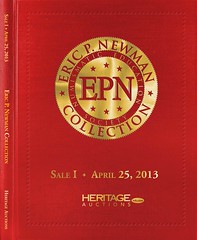 Kolbe & Fanning are continuing to accept subscriptions for the limited hardcover edition of the Eric P. Newman Numismatic Education Society sales. The first hardcover catalogue has already been produced, but copies are available for those entering new subscriptions. The hardcover edition of Sale II should be available by the beginning of 2014 (they have the prices realized list bound in, so cannot be produced until after the sale). For more information, or to subscribe, go to
www.numislit.com/shop/numislit/01737.html
or call David Fanning at (614) 414-0855.
Kolbe & Fanning are continuing to accept subscriptions for the limited hardcover edition of the Eric P. Newman Numismatic Education Society sales. The first hardcover catalogue has already been produced, but copies are available for those entering new subscriptions. The hardcover edition of Sale II should be available by the beginning of 2014 (they have the prices realized list bound in, so cannot be produced until after the sale). For more information, or to subscribe, go to
www.numislit.com/shop/numislit/01737.html
or call David Fanning at (614) 414-0855.
BOOK REVIEW: A GUIDE BOOK OF CIVIL WAR TOKENS
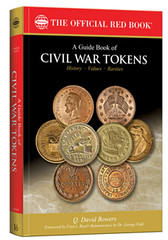 A Guide Book of Civil War Tokens “The Official Red Book,” History – Values – Rarities, Author Q. David Bowers, Foreword by Fred L. Reed, Reminiscence by Dr. George Fuld, Whitman Publishing, LLC, Atlanta, GA, 2013, Reviewed by John and Nancy Wilson, NLG
A Guide Book of Civil War Tokens “The Official Red Book,” History – Values – Rarities, Author Q. David Bowers, Foreword by Fred L. Reed, Reminiscence by Dr. George Fuld, Whitman Publishing, LLC, Atlanta, GA, 2013, Reviewed by John and Nancy Wilson, NLG
This guide book was recently released by Whitman Publishing, LLC, at the August, 2013 ANA World’s fair of Money, in Rosemont, IL. This is Volume 16 in the Bowers Series. The soft cover 448 page 6 x 9” reference has over 2000 photos. The book is the result of a lifetime of interest and study by Mr. Bowers in Civil War tokens since 1958; when Dr. Fuld offered him thousands of Uncirculated CWTs for $1 each. In the Reminiscence Dr. Fuld “recalls buying the D. C. Wismer collection in 1951 – a massive group of 11,000 Civil War Tokens – for 6 cents each!”
Dave Bowers has brought to the numismatic community one of the most important references released in many years, this Guide Book of Civil War Tokens. Much of the information contained in this new reference came from the 1972, Second Edition, George and Melvin Fuld, U. S. Civil War Store Cards standard reference which contained over 600 pages. That 1972 reference is long out of print, but due to great demand the Civil War Token Society (CWTS) has reprinted it. It is available from the society at: http://www.cwtsociety.com/. The Civil War Token Society is working to update the Fuld reference which hopefully will be released in 2014.
Though Mr. Bowers used information from the 1972 Fuld reference, he has “gone far and beyond” what was contained in that book. In his great style of writing he made many corrections and additions for this new book, including prices. All the Fuld numbers are used in this reference for Patriotic and Civil War Tokens (Store cards.) Within the pages of this important reference it has an introduction, seven chapters, five appendixes, credits & acknowledgments, and an index.
Chapter 1. Overview and Key to Using This Book. You will learn that these tokens were issued between 1861 and 1865 in various metals, numismatic strikes, how many die combinations were made, and the CWT suggested size that a CWT has to be, if it will be “official.” Information on Civil War Patriotic & Store Cards will be found along with the metals used and rarities.
Chapter 2. Before the Civil War. The North and South differences are explained and a discussion about early collectors such as Sage, Bushnell, Woodward and others along with interesting stories on CWTs and early cataloging and sales is covered. John Stanton’s tokens are explained along with the November (1860) Presidential Election. A Broadside published in South Carolina has information on when “exactly” the South seceded from the USA.
Chapter 3. Money of the Civil War. Twenty-eight pages of information on all the money that would have been in use from early 1861 through 1865. CWTs are also covered. The author also covers before and after Fort Sumter, Bull Run, Forts Henry and Donelson.
Chapter 4. Civil War Tokens and The History of Collecting Them. An explanation of the timeline of collecting interest for CWTs and the persons who were involved. Two great 1863 newspaper accounts talk about collectors and “tradesmen’s tokens” and “store cards.” The first known cataloging of CWTs was done by Pliny E. Chase. Information regarding him and the seven different classes of tokens he identified is given. Biographies of great collectors such as Levick, Groh, Idell and Heath are given. The Hetrich-Guttag 1924 “Civil War Tokens and Tradesmen’s Card” reference was the first book on the subject. How the Civil War Token Society was formed in 1967 is explained.
Chapter 5. Aspects of Collecting Civil War Tokens. Explanations of, Ways to Collect, Patriotic CWTs & Civil War Store Cards, The Marketplace and Grading, Being a Smart Buyer, Dealers and Other Sellers, Enjoying your Civil War Token Collection, Directories, the Internet, and Other Sources, Auction Catalogs, Price Lists, and Numismatic References, and Myths and Legends, Diameters and Striking Considerations, Studying Die States, Focus on the Styles Used by Several Shops, Studying Numerals, Letters, and Stars, New Discoveries, and the Tokens of Yankee Robinson are all part of this chapter.
Chapter 6. Patriotic Civil War Tokens. The 108 pages in this chapter cover these important tokens. The last reference on Patriotic Civil War Tokens was a Fourth Revised Edition in 1982, by The Civil War Token Society and authored by George and Melvin Fuld. That edition was updated in 2007 and this 5th Edition is now available from the Civil War Token Society at their web site. Mr. Bowers utilized the numbering system from that reference in his book. The 2007 Fuld reference only had an average price for rarities and the Bowers reference lists all the prices individually for the pieces along with their rarities. The firms and individuals who were involved in the issues are covered thoroughly. The two main classes of Patriotic CWTs with six pages of enlarged color photos are given. Patriotic civil war token varieties are next and all 537 die varieties are fully illustrated in color with prices given for several different grades and rarities.
Chapter 7. Civil War Store Cards. The main features of this reference are the Civil War Store Cards, which will be covered in the next 404 pages. There are many updates and corrections from the Fuld book of 1982. A new state, Louisiana, has been added and though it is a counter-stamped coin it was issued during the Civil War period. This will be a true rarity if you collect them by state like we do and everyone wants one. Though it is only an R-7 with 11 - 20 known the demand will quickly outstrip the supply. Cities and merchants have been delisted (or actually changed states) and might now be non-contemporary (not issued during the 1861 - 1865 period). At least one Wisconsin CWT that was listed in the Fuld reference will be listed in the new Fuld book when it is published as non-contemporary. It is a WI 510D Best & Co.
With all the states, towns and merchants listed (many illustrated in color), along with current market values and rarities, we have used our reference extensively for purchases. This reference is very valuable to us as we collect all the merchants from WI (one of each with Milwaukee complete), one from each state (completed), and are attempting to get one each from all the cities that issued them (totaling about 400). This city set will never be completed because one city has only one merchant and two pieces from that merchant with one piece in a museum. Several other cities are very rare with few CWTs known. The idea to collect by city was given to us by the author of this book, Q. David Bowers. For the reader of this review the selling or buying of one Civil War Token would pay for this reference multiple times. Being the size of a Red Book of U. S. Coins, this reference is easy to carry and use. To us and probably many other collectors and dealers, this reference is priceless and very valuable as we pursue that CWT that will help us to complete our collection.
Appendix I. Selected Civil War Token Engravers and Coiners. If you ever wondered who the people were who issued these tokens this chapter covers them all. From, C. Barkley, Die Sinker NYC who in 1863 advertised “Copper Tokens, Checks & Medals forwarded promptly by express to all parts, in any quantity and at the lowest prices;” to J. G. Wilson of NYC.
Appendix II. Locations Unknown Civil War Store Cards. Maybe you could help locate one of the 20 different businesses or merchants listed on the page? They are all believed to have issued CWTs, but their location is needed.
Appendix III. Fuld Numbers Now Non-Contemporary. The one page listing has Fuld numbers assigned to them in the second edition, but in the third edition will be given NC (Non-Contemporary) designations. The WI 510D is listed here in this new Bowers reference.
Appendix IV. Non-Contemporary Store Cards, By Issuer. The four page listing has Civil War era issues now classified as having been made before April, 1861 or after 1865. Another useful section that gives you a head start with knowledge before the new Third Edition by George and Melvin Fuld is released sometime in the future. If you can prove that any of these is actually a CWT, you can notify the CWTS with the information.
Appendix V. Encased Postage Stamps of 1862. This section gives you a brief overview of what they are along with information and rarities of the issuers. They were issued in denominations from one cent to 90 cents.
About the Author, Credits and Acknowledgments and the Index. Information on the author and the numismatists and institutions that helped him with this reference will be listed. The acknowledgments and index is helpful to researchers.
We would like to pay tribute and dedicate our review to two great numismatists that are no longer with us. The first is Dr. George J. Fuld, who co-authored the 1972 Second Edition of A Guide Book of Civil War Storecards. He did the Reminiscence for this reference we are reviewing. The next is our good friend Stephen L. Tanenbaum, who was killed on the streets of Brooklyn, NY in 2011 at the age of 62. Over the years we had purchased many tokens from Steve’s bourse table. He was always fair and honest in all his transactions with us. We also bid against each other at several auction sales over the years. We had always thought he was purchasing the items for customers and had no idea that he was purchasing most of the lots for himself. Since his passing, we can see that he was one of the greatest collectors of Civil War Tokens of all time. He was an officer, hard worker and researcher for the Civil War Token Society. His loss was felt not only by his family and all the members of the CWTS but his many dealer and collector friends in the numismatic hobby. With Steve’s passing, many ultra-rare CWTs have come into the market place in very high grades. We have purchased some of his CWTs through the listings of Q. David Bowers and Stephen Hayden.
We enjoyed doing this review and think it will be another best seller for Whitman Publishing; and come in second for sales next to the annual Guide Book of U. S. Coins now in its 67th Edition (2014). The knowledge and research abilities of the author, Q. David Bowers is astonishing. His writing style is excellent and his references are laid out in an easy to read and interesting manner. We recommend this book to everyone who has an interest in the Civil War and the financial tokens that were issued during that period.
This Official Red Book – A Guide Book of Civil War Tokens is available from the publisher for $24.95. They can be contacted at: Whitman Publishing LLC, 3101 Clairmont Rd., Suite G., Atlanta, GA. 30329, Phone Number (800) 546-2995 or www.whitmanbooks.com
BOOK REVIEW: MONNAIE ET JETONS DE L’INDOCHINE FRANÇAISE
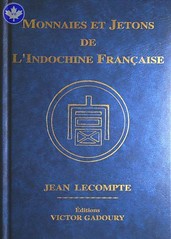 LECOMPTE, Jean. Monnaie et jetons de l’Indochine française. Monaco, Éditions Victor Gadoury, 2013. Hardbound, glossy paper. 15 × 21 mm. 168 pp. 800 pieces listed. 700 colour photos. French with the bulk of the text also in English. 49 euro. ISBN 978-2-906602-42-7.
LECOMPTE, Jean. Monnaie et jetons de l’Indochine française. Monaco, Éditions Victor Gadoury, 2013. Hardbound, glossy paper. 15 × 21 mm. 168 pp. 800 pieces listed. 700 colour photos. French with the bulk of the text also in English. 49 euro. ISBN 978-2-906602-42-7.
Although Lecompte deems it a third edition, it is the first time Coins and Tokens of French Indochina is published in this format. Indeed, the topic was previously covered in Lecompte’s Monnaies et jetons des colonies françaises (Coins and Tokens of French Colonies). He has decided to break that massive book into several volumes, and this is the first one. This book is not, however, a simple extract from the previous one; the contents has been greatly enhanced.
The coins, medals, patterns, tokens, and trial pieces issued over a century (from the 1850s to the 1950s) for the following areas are presented: Annam, Cambodia, French trading posts in China (Kwang-Chu-Wan, Shanghai, Tianjin), Cochinchina, Indochina, Laos, Siam, Tonkin, and Vietnam.
In addition to the information normally found in catalogues (denomination, year, type name, composition, weight, size, edge type, type of strike [coin or medal], engraver, mintage figures, and value for four grades), Lecompte provides detailed historical background both on the areas for which the pieces were issued and on the pieces themselves (in both French and English). He often provides references to articles with even more detail, published in the publications of the Société de numismatique asiatique and the Société d’études numismatiques et archéologiques.
The colour images are of the best quality pieces Lecompte could find, many of them are unique and coming from private collections, and are of the highest quality.
In conclusion, this book is an amazing reference for the collector specialized in this area. Highly recommend despite its high price.
For more information, contact www.gadoury.com.
BOOK REVIEW: FRACTIONAL MONEY BY CAROTHERS
Since you invited us to submit reviews of older books. . . Today I write of the foundational text of American numismatic researchers, the book that should need no introduction. . .
In 1997 I was still fairly new to coin collecting and hadn't really bought more than one or two numismatic books. I was familiar with Q. David Bowers, because a friend of mine had given me his majestic silver dollar encyclopedia (a gift less expensive than you might think, I hasten to add, because it was purchased at what-turned-out-to-be the much-discounted initial price offered in Coin World).
After reading the encyclopedia, I began to ask some of the questions that started me on the road to becoming a numismatic researcher. I didn't want to look at coins through a microscope, I wanted to know "why" - why were so many Morgan dollars minted when silver dollars had never been popular? ... that sort of thing.
Knowing that Mr. Bowers was an established numismatic researcher, I attended the 1997 ANA Convention in New York determined to speak with him about what I should do to conduct numismatic research. I was determined to ask coherent, intelligent, questions.
Well, of course, when my opportunity came, Mr. Bowers was in the midst of a number of activities and I was pretty tongue-tied.
Gazing sympathetically at me after I finally choked out something mildly incoherent, he said: "Well, you should really start by reading Fractional Money by Neil Carothers."
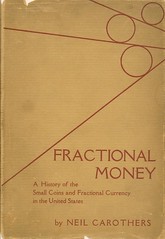 Published in 1930, Fractional Money started life as Mr. Carothers' PhD thesis at Princeton University. The book is a history and discussion of American money (mostly that of coins that were "fractions" of a dollar - get it, "fractional money"!) from the earliest days of the Colonies up to just past World War I. He discusses the use of money in the Colonies and during the Revolution, the various State coppers, the development of the American coinage system, the effects of the various coinage laws of the early to mid-19th century, the effect of the California Gold Rush on silver coins, the introduction of subsidiary coinage, the effects of the Civil War and the Greenback era, the coinage law of 1873, the restoration of convertibility and the Trade Dollar and the standard silver dollar. I know of no other book that so well integrates the story of American coinage with the economic events of the 19th century that so affected that coinage.
Published in 1930, Fractional Money started life as Mr. Carothers' PhD thesis at Princeton University. The book is a history and discussion of American money (mostly that of coins that were "fractions" of a dollar - get it, "fractional money"!) from the earliest days of the Colonies up to just past World War I. He discusses the use of money in the Colonies and during the Revolution, the various State coppers, the development of the American coinage system, the effects of the various coinage laws of the early to mid-19th century, the effect of the California Gold Rush on silver coins, the introduction of subsidiary coinage, the effects of the Civil War and the Greenback era, the coinage law of 1873, the restoration of convertibility and the Trade Dollar and the standard silver dollar. I know of no other book that so well integrates the story of American coinage with the economic events of the 19th century that so affected that coinage.
Of course, as you might expect of a PhD thesis, the book is heavily footnoted and Mr. Carothers provides an extensive bibliography. Well! In my eyes, these are the best features of the book! If you want to learn what monetary economists thought in the 19th century, you need only to plunder the bibliography to find everything from William Gouge's Short History of Paper-Money and Banking (1835) to John Jay Knox's United States Notes (1885) to A. Barton Hepburn's History of Currency in the United States (1924). If you didn't know that Hunt's Merchants Magazine, Bankers Magazine and Niles' Weekly Register existed, you would learn of them here. If you didn't know that the Mint published annual reports that provided more than mintage numbers or that the Secretary of the Treasury also published annual reports that touched on a variety of topics, you would learn that here.
Needless to say, the whole world of primary source material opened to me once I took Mr. Bowers' advice.
What more can I say about a book that opened a whole world to me?
The book is available in two hardcover editions and, apparently, two paperback editions. The original 1930 hardcover edition by John Wiley & Sons seems to be the hardest to find. In 1967, Augustus M. Kelley reprinted the book in hard cover as part of its Reprints of Economic Classics series.
In 1988, of course, Bowers and Merena produced the facsimile paperback edition that we see most often and in 2007, apparently, Kessinger Publishing released a paperback edition, as well.
Copies of the book are available through Bookfinder.com as well as from numismatic booksellers and through numismatic book auctions.
I, of course, still have the Bowers and Merena paperback I acquired in 1997 and, I'm pleased to say, I just acquired a copy of the Kelley hardcover - my paperback copy having been read a number of times, I don't want to wear it out!
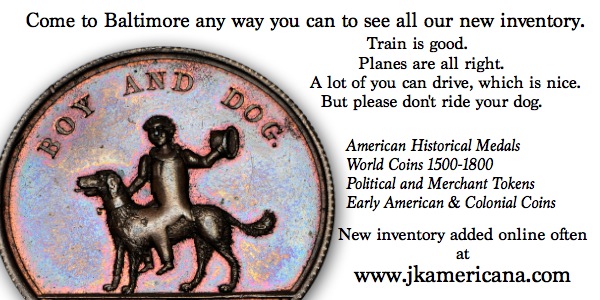
NOTES FROM E-SYLUM READERS: NOVEMBER 3, 2013
The International Congress on Medieval Studies Bob Leonard writes:
I fear that it has been many, many years since Joel Orosz attended the International Congress on Medieval Studies. After Medieval Curator Alan Stahl left the ANS in 2000, the American Numismatic Society stopped supporting it. (I have urged Ute Wartenberg Kagan to resume, but that must await the appointment of a new Medieval Curator.) Since 2000, an ad hoc group, Numismatists at Kalamazoo, has kept the numismatic session going, with unfailing help from Dr. Stahl. However, the ANS reception is a thing of the past!
For anyone with the least interest in medieval coins, the Medieval Congress is an incredible treat. True, there will typically be only two to six papers on medieval numismatics, but the Book Exhibit covers all the academic publishers--and at significant discount prices. Several out of print dealers set up also. There is even a coin dealer, Allen Berman! I probably am making a mistake in revealing this, but I have purchased a number of scarce numismatic books there over the years, usually at favorable prices.
To read the earlier E-Sylum article, see: MEDIEVAL INSTITUTE PUBLICATIONS SEEKS MANAGING EDITOR (www.coinbooks.org/esylum_v16n44a24.html)
Rare Coin Vending Machine
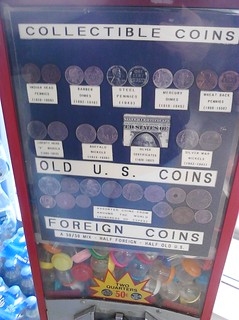 In an email with the subject line "Rare coin gumball machine?", Hubert Walker writes:
In an email with the subject line "Rare coin gumball machine?", Hubert Walker writes:
This is the first one of these I've ever seen. Found it at a gas station on N Main St in Clinton, TN., and thought it might interest you and your readers.
Heritage Seeks U.S. Coin Cataloguer
Mark Van Winkle of Heritage Auctions writes:
We just hired a full-time U.S. coin cataloger who is going to move here to our Dallas headquarters. I keep getting applications, though, maybe every other day for a remote cataloger position. Most of them don’t have the vaguest idea of what is required. Many of them only have an in-home library that consists of a Red Book and a Breen book. I received one application from a gemologist! We would still like to hire at least one more remote cataloger, so please keep our ad running.
More on the Copper Coinage of the Habsburgs
Regarding the "Los Austrias Coppers" book I asked about last week, Francois Velde writes:
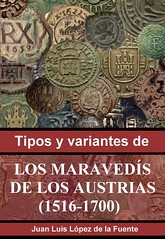
According to Google Books, the book was published in 2011. I haven't seen it but it must be an improvement on what existed 15 years ago when I researched this topic. "Los Austrias coppers" means the copper coinage of the Habsburgs (as we call them now, the House of Austria as they were known).
Ron Haller-Williams writes:
An extract is available. The copyright date range of 2006-2013 probably reflects work leading up to this and the earlier publication of parts e.g. in talks, articles, etc. They also have some other interesting books
To read the extract, see: Los maravedís de los Austrias (1516-1700) (www.maravedis.net/PDF%20los%20maravedis%20de%20los%20austrias.pdf)
To see the other books for sale, visit: www.maravedis.net/libros.html
To read the earlier E-Sylum article, see: NEW BOOK: THE LOS AUSTRIAS COPPERS (1516-1700) (www.coinbooks.org/esylum_v16n44a05.html)
Bryce Brown's Thanksgiving Offer Numismatic literature dealer Bryce Brown writes:
My specialty is "filling in the gaps" in researchers' libraries. My website is reasonably up-to-date, so I thought I'd offer E-Sylum readers a Thanksgiving Special: Free domestic postage for any $100 order in the month of November.
To visit Bryce's web site, see: Bryce Brown's Coin Auction Catalogs (brycebooks.squarespace.com)
On Grading 'Reconsideration' Alan Luedeking writes:
Is anybody else as steamed about the new PCGS ad as I am?
Here's a quote from the ad:
"RECONSIDERATION is a new service level from PCGS that allows you to submit your coins for regrading without the risk of a potential crack out if the coin does not receive an upgrade."
PCGS now has a vested interest in grading too low the first time around since they can collect a premium from you every time they increase the grade by a point! They're asking you to pay to correct their mistake! So what happens if they graded it too high? What ever happened to "getting it right the first time"?
God said go forth and multiply, and soon there were grades aplenty, some seventy in all. And God said it was good. But one day Adam prayed to God, asking for the wisdom to tell the difference between Steve's MS-63 and MS-64. And so the Lord unleashed upon the land a bevy of fourth-party graders, to grade the grades of the graders.
And one day Adam prayed to God, asking "Lord, forgive me, for I can no longer see thy coins. And God saw that indeed, the coins were obscured by layers of plastic emblazoned with lengthy hieroglyphic grade descriptions, and encrusted with multiple stickers of approbation.
And God said, "What hath I wrought?"
[Like all grading service innovations beforehand, this one was undoubtedly created in response to a perceived need, pressure from competition, or both. The PCGS ads state that it was requested by their users. And like all other innovations it will have consequences on the industry, intended or otherwise. But none of us can truly predict what they will be. The only sure thing is that there will always be differing opinions. -Editor]
THE BOOK BAZARRE
THE GILCREASE MUSEUM, TULSA, OK
My wife and I are visiting our daughter in Tulsa, OK and we took a little side-trip to the Gilcrease Museum, where they have a phenomenal collection of Western Art and Amerindian historical items. In one of the display cases was a Washington Oval Peace Medal which prompted my remark, "I wonder if it's real."
In our obligatory trip to the museum gift shop, I browsed the books for anything of interest and found "Peace Medals: Negotiating Power in Early America", edited by Robert B. Pickering, Ph.D. and published in 2011 by the Gilcrease Museum. The book looks at Indian Peace Medals from an historical perspective rather than a numismatic one, but there is a great chapter by the late, great George Fuld on Washington Oval Peace Medals where he lists a census of known examples. Therein, the Gilcrease example is listed as one of the 1792 Small Size Oval Peace Medals.
Also, the museum has a bronze bust of an Indian Chief by Adolphe A. Weinman (designer of the "Mercury" Head Dime and the Walking Liberty Half Dollar) and a bronze bust of an Indian astride a horse by Cyrus Dallin (designer of the 1920 and 1921 Pilgrim Half Dollars).
Sometimes, I forget that the world of numismatics shares some of its brightest stars with other spheres in life, and it is always surprising to make the connection.
For more information on the Gilcrease Museum, see: http://gilcrease.utulsa.edu/
HARVEY STACK REMEMBERS GEORGE F. SCANLON
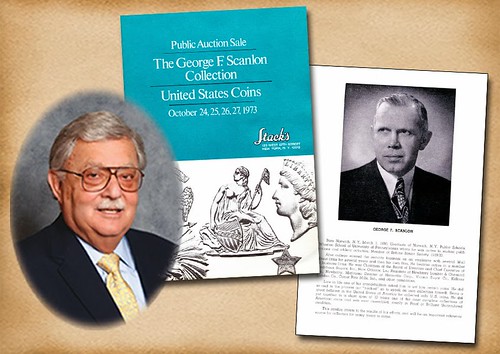
Born and brought up in Norwich, New York, he graduated from the Wharton School of Business at the University of Pennsylvania. After graduating in 1920 he entered into the security business. He was a successful officer or director of Godchaux Sugar, Newberry Lumber and chemical, Hermetite, Vicana Sugar, Kellogg Lumber Co., Comet Rice and other successful companies.
Somewhat late in life his grandchildren asked him questions about certain coins and he "became hooked" on coin collecting. He tried to assemble several collections (to be shared with his grandchildren), and tried to acquire as many different examples to complete certain series. His desire for beauty and quality led him to collect as many different Proof and Uncirculated specimens as he could.
He possessed a large offering of copper coins -- half cents and large cents -- in choice condition. His small cents included several dated 1856 and a Proof 1864 L from the Charles Jay Collection. He had two, three and five cent pieces in both Proof and Uncirculated. In silver he had half dimes through silver dollars in outstanding grades, acquired from many Stack’s auctions of prior years. He had early Proof sets, starting with 1858 and complete to 1915, many in their original wrappings from the Mint.
His gold coins comprised gold dollars to double eagles, with examples pedigreed to famous sales of prior years including that of George Walton, the source of most of his Southern gold. Again, the series were not complete, but included many Mint State and Proof examples.
Mr. Scanlon personally attended auctions and examined all lots he bid on. He liked to sit in the corner of the room, listen to the action, make voluminous notes and bid enthusiastically for the items he wished to add to his holdings. He mostly kept to himself, but was very close and friendly with what he termed " his favorite coin auctioneers," who helped him with guidance and valuations so he could be competitive. He had somewhat of a New England temperament, always wore a suit and a tie to a sale and could become stubborn when he really "wanted or needed something." As a student of coin values, he knew what he was doing and was not afraid to let his competitors know that "he knew" and that he could not be "run up" by others around him.
However, a flood occurred in a bank vault where he stored his, and while his coins were fortunately not hurt, this led him to decide to make his coins available to the market.
To read the complete article, see: Remember When: George F. Scanlon (stacksbowers.com/Blogs/remember-when-george-f-scanlon.html)
THE MOUNT RUSHMORE FIVE-OUNCE SILVER COIN
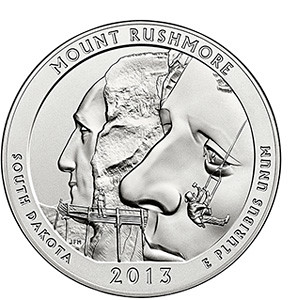 Beginning at noon Eastern Time (ET) on November 7, the United States Mint will accept orders for the 2013 America the Beautiful Five Ounce Silver Uncirculated Coin—Mount Rushmore National Memorial. Mintage for this coin is limited to 25,000 units.
Beginning at noon Eastern Time (ET) on November 7, the United States Mint will accept orders for the 2013 America the Beautiful Five Ounce Silver Uncirculated Coin—Mount Rushmore National Memorial. Mintage for this coin is limited to 25,000 units.
The America the Beautiful Five Ounce Silver Uncirculated Coins are collector versions of those issued through the America the Beautiful Silver Bullion Coin™ Program. The designs on each coin are identical to the ones that appear on the corresponding circulating quarters issued through the America the Beautiful Quarters® Program. The bullion coins, however, do not have a mint mark.
The America the Beautiful Five Ounce Silver Uncirculated Coins are struck in .999 fine silver and display the "P" mint mark indicating their production at the United States Mint at Philadelphia. Each coin is enclosed in a protective plastic capsule and placed in an attractive presentation case. A Certificate of Authenticity is included.
For more information, or to order, see: 2013 America the Beautiful Five Ounce Silver Uncirculated Coin™ - Mount Rushmore National Memorial, South Dakota
QUERY: WHERE DID A THOUSAND 1792 HALF DISMES GO?
The October 29 episode of "Castle" on ABC had a plot that involved discovery of a hoard of 1792 half dismes. They showed a bucket of the coins and the suggestion that there were a thousand of them. There was the comment that one recently sold for $1.5 million dollars.
The addition of a thousand Mint State coins would probably depress the market. Dumping a thousand replicas could also depress the market.
I attempted to contact ABC Television and got a form letter non-response. I wonder if any of our E-Sylum readers has an inside connection with ABC and can get some answers. Where did they acquire the copies? How many did they have? What happened to the copies after producing the show?
I know it is currently possible to order replicas from China and perhaps this is what they did. These replicas are an obvious problem today. If there are another thousand dumped on the market, it will continue to cause problems for generations into the future.
To watch Castle episodes online, see: abc.go.com/shows/castle

COLLECTOR MARY B. BLANKENBUEHLER INFORMATION SOUGHT
Mike Paradis writes:
I recently purchased an unplated Chapman Stickney sale with the name M. B. Blankenbuehler inscribed in period script at the top of the first page of the auction lots. What I found interesting is that it appears the M. is for Mary. She came from Washington County Pa. which is where I purchased the catalog from.
I would like to know if I got the M as Mary correct. Next, I am sure someone has discussed women at auction sales, but I was wondering if she attended the sale and how common that would have been in 1907? The PRL has three lots with an * next to them. The most significant one is lot 37. Maybe she purchased it? Boy I wish I had a priced & named sale.
Mike forwarded the lot descriptions (lots 37, 41 and 283a). He said 283a is not listed in the catalogue but is in the PRL. Thanks!
37 1670 Louis d'Or. Exquisite bust of Louis XIV, unlaureated and undraped to right, the hair in great profusion falls down over both shoulders, LVD. XIIII D. G FR. ET. NAV. REX 1670. Above head sun in splendor; badge of Louis XIV; below bust the date. R. Cross composed of addorsed L's crowned and the angles filled with a fleur-de-lis, in center in circle a the mint mark of Paris, CHRS. REGN. VINC. IMP small castle, probably Mint Master's mark, after this last word. Gold. Extremely fine. The only example I have ever seen and here offered for the first time, I believe, in America. I have not been able to find it described in any book relating to America, but firmly believe it to have been, as the workmanship is similar to the last described coin, the date the same, also adjunct of the sun in splendor over head as on last coin. See plate.
41 1721 Sou. Crossed L's crowned, SIT NOMEN DOMINI BENEDICTUM. R. Across field COLONIES FRANCOISES. 1721 H MM of La Rochelle. Fine. Evenly struck. Breton 506. Leroux 253.
IMAGES OF HAROLD NEWLIN AND ROBERT COULTON DAVIS SOUGHT
David Stone of Heritage Auctions writes:
I am requesting some help from E-Sylum readers with a research project. I need to find photographs or portraits of Harold P. Newlin (attorney and 19th century collector, who wrote the first reference on Half Dimes) and Robert Coulton Davis (Philadelphia pharmacist and 19th century collector). Does anyone know where I can find any images? Thanks so much for any help you can give me.
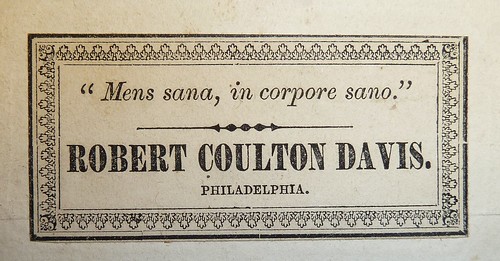
To read the complete article, see: A guide to the lions of Philadelphia (dla.library.upenn.edu/dla/franklin/record.html?q=5186523&id=FRANKLIN_5186523&)
DANIEL W. VALENTINE MEDAL CENSUS INFORMATION SOUGHT
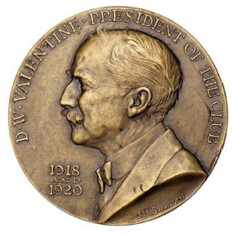
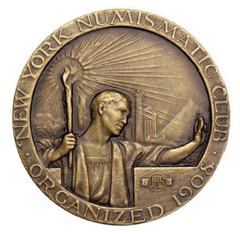
I'm working to build a census for determining how many of the New York Numismatic Club Medals of Dr. Daniel W. Valentine may survive. These medals are highly prized among half-dime collectors, fractional currency collectors, as well as NYNC members/medal collectors. This particular medal is generally viewed as the key to the series, as it is in high demand by members of these groups.
If you have one of these or know of the whereabouts of one, please send a note to me at jerry@fochtman.us and simply give me the serial number of the medal you/they possess. The serial number is found on the edge of the medal, and should range from 1 to 50 for bronze medals, and 1 to 8 for any silver medals.

1892 LIBERTY SEATED COIN GLASS FOLLOW-UP
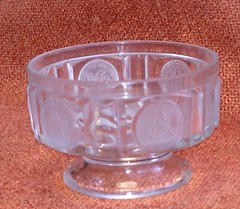 It has taken me several months to send a thank you, but I wanted to be sure to pass on my appreciation for your information helping me to research the 1892 Seated Liberty Coin glass dish I gave my grandson for his high school graduation.
The progression of my research is as follows.
It has taken me several months to send a thank you, but I wanted to be sure to pass on my appreciation for your information helping me to research the 1892 Seated Liberty Coin glass dish I gave my grandson for his high school graduation.
The progression of my research is as follows.
With the initial information you provided about the 1892 Seated Liberty glass piece I presented it to my grandson with the conclusion that although it represented a very interesting piece of World's Fair history, I could not say if it was an original or a copy. However I still felt it was a nice piece of his great grandfathers glass collection to pass on.
The day after the graduation party, I got your email that forwarded Mr Bailey's comments stating that as far as he knows there were no copies of this glass. This meant to me that the glass was likely an original, but where did it come from?
Then remembered that in a journal written (in Norwegian) by my grandson's gt gt gt grandfather, Christopher Evans where he mentioned he attended the Chicago fair not once but twice and brought home souvenirs. For me that completed the provenance of this piece as it directly connected the Evans' family members who passed on this gift.
It first came to Christopher's grandson, Rudie, a collector of antique and collectable American glass and eventually to his son, my husband, Robert. This is the glass piece, passed down 4 generations, that was given to our grandson, Anders Conroy for his high school graduation. He is attending business college at Des Paul University in Chicago and was so pleased to have this gift of history from both Chicago and his family. I wanted to pass on the conclusion of my research along with many thanks for your help. I was thrilled to put these last pieces together and could not have without your and Mr Taylor's help.
To read the earlier E-Sylum articles, see:
ANOTHER LIBERTY SEATED COIN GLASS SAUCE DISH
(www.coinbooks.org/esylum_v16n20a16.html)
BOOK: U.S. COIN & COLUMBIAN COIN PATTERN GLASS
(www.coinbooks.org/esylum_v16n21a04.html)
MINT PRESS NO. 1 MAKES NEVADA SESQUICENTENNIAL MEDALS
Nevada Coin Press No. 1 is like its volunteer operator, Ken Hopple: Both just keep going and going.
“Give it a little grease and keep up with the repairs and it will last forever,” said Hopple of the antique press in the Nevada State Museum that on Friday manufactured the first of the 1,000 silver medallions commemorating Nevada’s 150th birthday celebration.
The Morgan and Orr press made coins way back in the 1870-93 period when the U.S. Mint operated in Carson City. Those coins carried the numismatic-cherished “CC” mint mark. The mint building since 1941 has housed the Nevada State Museum.
At a six-medallions-a-minute production rate, Hopple made the first medallions in front of crowd that included Gov. Brian Sandoval.
At 68, Hopple still is a full-time tool and die maker in Reno. He spends the last Friday of each month running the press to make state medallions and to talk to schoolchildren about coin-making, coins and their history.
His fee: One of each medallion that he makes.
“My work is basically like a donation to the museum,” Hopple said.
Not only did Press No. 1 make coins — at a 100-per-minute rate — in the Carson City Mint, but it also went on a long road tour to work in the mints in Philadelphia in 1899-1945 and then to the San Francisco Mint, 1945-55. It was manufactured in 1868.
It was destined for a salvage lot in San Francisco until a smart mint worker noticed it had a Virginia & Truckee Railroad plaque, a plaque placed on it when someone in the historic Carson City railroad yard repaired it in 1878.
Because of his intercession, the press was returned to Carson City — for $255 — where it was put on display in the state museum until 1964.
Then U.S. Mint Director Eva Adams, a Nevada resident, requested the press be put back in service at the Denver Mint. Three years later, after making 188 million more coins, the press was returned to Carson City. Since then, it has been making state medallions.
“It’s like old cars; it is built to last forever,” said Hopple, who talks about the press as if it were a friend.
To read the complete article, see: 1868 press used to mint Nevada anniversary coins (www.reviewjournal.com/news/1868-press-used-mint-nevada-anniversary-coins)
To read another article on the striking of the medals, see: First Nevada 150th anniversary coin comes off the press (www.reviewjournal.com/news/first-nevada-150th-anniversary-coin-comes-press)
HOWARD BERLIN VISITS SLOVENIAN NUMISMATIC COLLECTIONS
I feel a bit like Willie Nelson’s song, On the Road Again. My first numismatic venue on this trip is the National Museum of Slovenia (not Slovakia!) in the capital city of Ljubljana. At a population of about 250,000, this capital city of this former Yugoslav republic is one of the smallest capital cities in Europe. I don’t speak Slovenian, but the language is similar to Slovak, my wife’s native language, and many words are similar to Russian, which I actively stopped speaking more than 50 years ago. Not as many people on the street speak English as you would expect, but still I managed to get around, sometimes speaking German, English slowly, and what little Italian I learned from my barber.
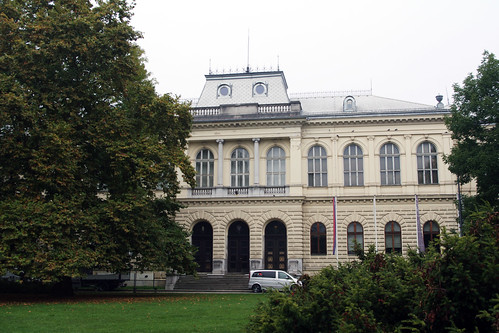 National Museum of Slovenia
National Museum of Slovenia
The National Museum of Slovenia is a brisk walk from my hotel in the staro mestno, or Old Town. Actually, the museum building houses two museums. One half houses the National Museum of Slovenia where the numismatic cabinet is. The other half is the Slovenian Museum of Natural History. Unlike most of the museums I visit that have numismatic collections, there is no permanent or temporary exhibition of its collection. In fact, there is no public numismatic exhibition in all of Slovenia. Nonetheless, I wanted to touch base with these people and shamelessly promote my forthcoming book while I was there.
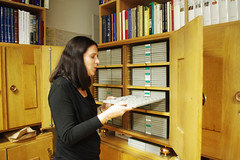 I was met at the museum by Dr. Alenka Miškec, the head of the museum’s coin cabinet, and Prof. Dr. Peter Kos, also of the coin cabinet. They have approximately 100,000 specimens housed in pull out trays located in an uncontrolled environment. This is unlike vaults of the Smithsonian or Berlin’s Bode Museum which are temperature and humidity controlled. Besides having an ample collection of ancient Greek, Roman, and Byzantine coinage, there also small groups of more modern era coins from around the world. As for the U.S., their collection includes several trays of gold coins, ranging from quarter to double eagles. Besides the coins, the museum has a numismatic library, consisting of about 4,000 volumes.
I was met at the museum by Dr. Alenka Miškec, the head of the museum’s coin cabinet, and Prof. Dr. Peter Kos, also of the coin cabinet. They have approximately 100,000 specimens housed in pull out trays located in an uncontrolled environment. This is unlike vaults of the Smithsonian or Berlin’s Bode Museum which are temperature and humidity controlled. Besides having an ample collection of ancient Greek, Roman, and Byzantine coinage, there also small groups of more modern era coins from around the world. As for the U.S., their collection includes several trays of gold coins, ranging from quarter to double eagles. Besides the coins, the museum has a numismatic library, consisting of about 4,000 volumes.
Both Drs. Miškec and Kos escorted me on a tour of the building’s two museums. Although there is no permanent numismatic exhibit, I did notice a few coins that were integrated among some of the historical specimens. Visitors wishing to view the coin cabinet’s collection or research the library should make their request in advance along with the purpose of their visit.
From Ljubljana, my next intended numismatic venue was to travel to Sofia, Bulgaria to visit the Bulgarian National Bank’s (BNB) museum. It is located in the center of town and a block away from the Bulgarian president’s office, where one can see the periodic changing of the guard, and there was a small group of protesters with the local police looking on.
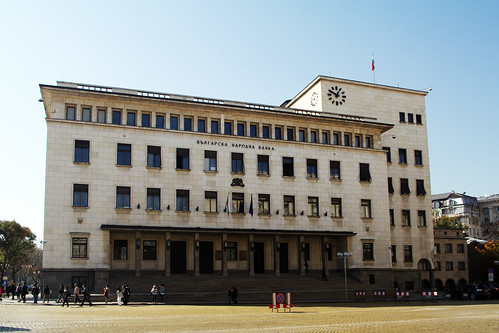 Bulgarian National Bank
Bulgarian National Bank
Unlike my visit in Ljubljana, my visit to the BNB museum was disappointing. I needed to go through a metal detector and my shoulder bag was scanned, which is typical for many bank museums. However the security personnel spoke only a very little English and it was difficult to make the purpose of my visit clear. Finally one gentleman signed me in and escorted me to the second floor where he unlocked the door to the museum.
As I am little bit handicapped and walk with a cane, I rely on using my camera to photograph the text material of the displays instead of having to take notes, which could take hours when there are many display cases. Since photography was not permitted (I knew this beforehand), I also was not permitted to dictate into my iPhone. I then determined that it would be impossible to remember virtually anything specific from the more than 14 cases in the museum. The English pamphlet given me was only of a general nature and I needed specifics about the coins and banknotes for an intended magazine article.
After three minutes in the museum, I then told my escort (using the Google English-Bulgarian translation app of my iPhone) that I apologized that this visit was a waste of time since I am unable to take any notes with my camera or cell phone. Other than this low point, I did enjoy visiting Sofia, taking in many of its cultural landmarks.
My next trip to museums will be to Zurich and Basel in February with a day trip across the border to Lörrach, Germany to visit the staff of MünzenWoche/CoinsWeekly.
THE BOOK BAZARRE
KÜNKER SALE NO 242 OF HISTORICAL MEDALS
1719 Silver Medal of Princess Maria Clementina Sobieski

Silver Medal 1719, by O. Hamerani, on the flight of the Princess Maria Clementina Sobieski from Innsbruck to Rome. Bust of Princess l with folded ermine / / The Princess in open Biga left, in the background the city View of Rome with the Colosseum and the Traiansäule and sea with sailing ship, r. rising sun. 48.44 mm, 56.22 g bucket 484; H.-Cz. 5960th showpiece. Gorgeous patina, extremely fine-uncirculated
King George I of Great Britain resisted the planned wedding of Princess Maria Clementina Sobieski of Poland with his pretender James III Stuart. By George I to do you a favor, Emperor Charles VI. the princess lay down in Innsbruck in a monastery. After a short time she managed to escape to Italy, first to Bologna, where she married James III Stuart by procurationem. Then they continued their journey to Rome.
To read the complete lot description, see: Lot number 3178 www.kuenker.de/AuktionDetail_en.kuenker?lager=00077&los=3178)
1727 Bronze Medal on Alps Road Construction
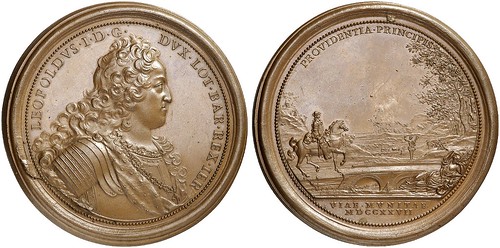
Bronze Medal 1727 (later coinage in 1800), by F. de Saint-Urbain, on the construction of a road across the Alps. Geharnischtes bust r. tilted back with jacket / / The Duke rides r. over a bridge and is greeted by Mercury, the background landscape. 62.78 mm Wurzbach 5129th Class stamp error, vorzüglich
To read the complete lot description, see: Lot number 3082 (www.kuenker.de/AuktionDetail_en.kuenker?lager=00077&los=3082)
1879 Medal of Adolf Erik Nordenskiöld
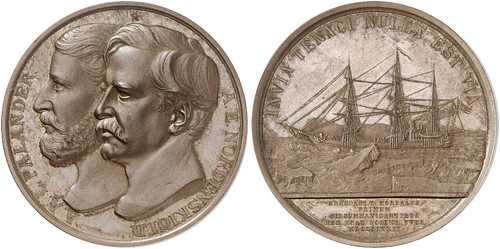
Bronze Medal, 1879, by Lea Ahlborn, the first northeastern passage through the Swedish polar explorer Adolf Erik Nordenskiöld of, donated by the Royal Swedish Academy of Sciences. Heads of Nordenskjölds and AAL Palander, commander of the whale catcher Vega, side by side l / / l sailing ship in the Arctic Ocean. 48.10 mm. Vorzüglich
The Swedish Baron Adolf Erik Nordenskiöld was the first scientist who managed to defeat the northeastern boat which, connects the Atlantic Ocean with the Pacific Ocean in northeastern Siberia together. Palander Luis Vega, an officer in the Royal fleet and companion Nordenskjölds, was rebuilt in 1878, the whalers Vega for the northeast passage. After the passage was succeeded after his return he was appointed captain in 1880 and elevated to the peerage.
To read the complete lot description, see: Lot number 3222 (www.kuenker.de/AuktionDetail_en.kuenker?lager=00077&los=3222)
MORE ON THE SAINT ELIGIUS MEDAL
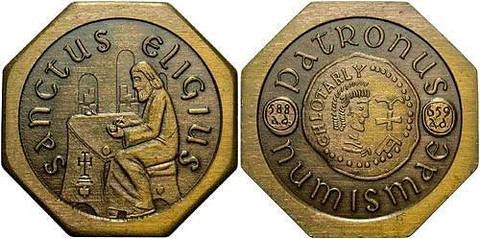
Howard A. Daniel III writes:
I bought the Saint Eligius medal that was in your last issue of The E-Sylum, and owned one for many years. I know I bought it sometime after coming back to the USA in 1973 after being stationed overseas for ten years, but I cannot remember the exact date. I mentioned it to a numismatist back in the 1990s and he was interested in it, so I mailed it to him because I was trying to slim down my miscellaneous collection. I think it came in a holder and with an information card/certificate but my memory has faded a lot about it. Hope this information helps Pabitra Saha in finding out more about it.
Joe Levine writes:
This medal was issued sometime in the middle 1960's (?) by the Washington, D.C. coin dealer, Phil Lampkin. Phil was the proprietor of Washington Coin Exchange located on Vermont Avenue.
Dick Hanscom writes:
I believe it was made by the Van Brook Mint, Lexington, KY. There is one on eBay right now.
To read the eBay listing, see: 1966- PATRON SAINT OF NUMISMATICS MEDAL BY VAN BROOK MINT OF LEXINGTON (www.ebay.com/itm/1966-PATRON-SAINT-OF-NUMISMATICS-MEDAL-BY-VAN-BROOK-MINT-OF-LEXINGTON-/181096190554)
Serge Pelletier writes:
Doug Andrews published an article in The Numismatist (circa 1994) on St. Eligius. Claude Proulx, a numismatist from the Montréal (Quebec) area promoted the patron saint of numismatist considerably in the 1990s. He even created the Knights of St. Eligius. Selected recipients were given a beautiful, large, pewter medal Claude had made. Among recipients were Frank Gasparro (Texas), Doug Andrews, and Bret Evans (editor of Canadian Coin News)
Dick Hanscom adds:
There is a very large medal of St. Eloi (Eligius) by the Paris Mint. It is huge, about 115mm.
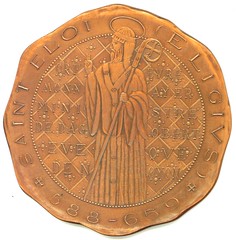
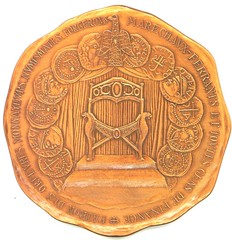
To read the complete article, see: SOME IMAGES FROM PABITRA SAHA: OCTOBER 27, 2013 (www.coinbooks.org/esylum_v16n44a11.html)
THE BOOK BAZARRE
ERIC NEWMAN PART III TO FEATURE WORLD COINS
Dozens of coins in Newman Part Three could be considered highlights, but several pieces stand out as world-class specimens due to their grades and rarity.
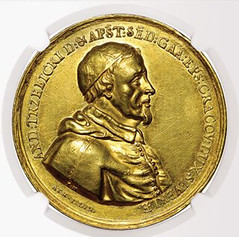
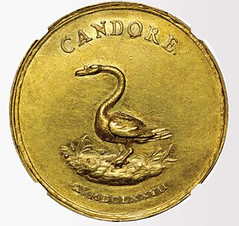
Among them is the Poland 1677 Andrezj Trzebicki Medallic Gold 10 Ducats graded NGC AU 58 and believed to be unique. In fact, prior to NGC's certification, this medal was undocumented in any numismatic references or auction catalogs.
The selections include a number of German States coins, which are led by three fantastic rarities. The German States, Salzburg, 1612 Markus Sittikus Graf von Hohenems Gold 14 Ducats is virtually unknown to the collecting community and probably unique. Graded NGC AU 58, this specimen is undoubtedly one of the world's greatest numismatic treasures.
The German States, Saxe-Altenburg, 1672 Gold 10 Ducats of Duke Friedrich Wilhelm III is unlisted in Krause Publications' Standard Catalog of World Coins and has never been pictured in a numismatic reference. One of only two or three thought to exist, it is graded NGC AU 58.
A third German States coin, the 1674 Leopold I City of Emden 2 Taler, is notable for both its remarkably high grade and extreme rarity. NGC has assigned a grade of MS 66, which was previously unimaginable for this issue. Only a handful of examples are known to exist and nearly all are in circulated grades.
British coins are also extensively represented in the Newman selections. An English penny of Alfred the Great, struck between 871 and 899, is truly a miracle of survival with a grade of NGC MS 63 -- an astonishing grade for a medieval silver coin. The attractive NGC MS 62 England (1594-96) Gold Pound of Elizabeth I is significant, as well.
An extremely rare Ecuador 1841 MV-A Gold 4 Escudos graded NGC MS 62 is certainly one of the greatest South American coins ever to be sold publicly. Once believed not to exist, it is now thought that only four examples survive.
Another spectacular gold piece from the Newman Collection is a Peru 1700L H Cob 4 Escudos of Carlos II. Graded NGC MS 65, this extraordinarily well-preserved example is likely the finest of any extant Carlos II gold coins. Also graded NGC MS 65 is the Transylvania 1613NB Gabriel Bathori Gold Ducat. Seldom available in any grade, the Newman specimen is easily the finest of its type.
Additional highlights from Newman Part Three are the Russia 1729 Peter II Gold Ducat in NGC AU 50, a rare variety of this issue; the NGC PF 64 Hong Kong 1866 Victoria Dollar, which is immensely popular with collectors; and the NGC MS 63 Sweden 1599 Karl IX Daler, a carefully preserved example of this rare, short-lived issue. The Italy Paolo III Gold 2 Fiorini di Camera, struck 1534-49, graded NGC MS 61 is notable, as well.
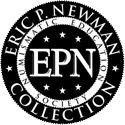 Newman Part Three will be sold by Heritage Auctions at its New York office January 14-16, 2014. The catalog, including images and descriptions, will be posted on the Heritage Auctions website (HA.com) later next month.
Newman Part Three will be sold by Heritage Auctions at its New York office January 14-16, 2014. The catalog, including images and descriptions, will be posted on the Heritage Auctions website (HA.com) later next month.
To read the complete press release, see: NGC Certifies Eric P. Newman World Coins (www.digitaljournal.com/pr/1556803)
THE NATIONAL NUMISMATIC COLLECTION RICHARD DOTY FUND
Help Honor Richard G. Doty & Proudly Support Our National Numismatic Collection
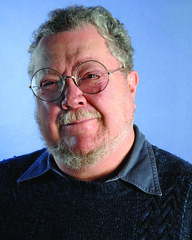 We will always remember Richard G. “Dick” Doty (1942-2013), senior curator with the National Numismatic Collection housed at the Smithsonian’s National Museum of American History. The National Numismatic Collection benefitted greatly from Dick’s guidance and expertise.
We will always remember Richard G. “Dick” Doty (1942-2013), senior curator with the National Numismatic Collection housed at the Smithsonian’s National Museum of American History. The National Numismatic Collection benefitted greatly from Dick’s guidance and expertise.
Join an international community of Dick’s colleagues and friends by making a donation in his memory. The Doty Fund will be used to purchase artifacts to add to the prestigious National Numismatic Collection. These new acquisitions will be credited in Dick’s memory in perpetuity.
To give, see: Help Honor Richard G. Doty & Proudly Support Our National Numismatic Collection (amhistory.si.edu/donate/doty.cfm)
NORWEGIAN MAN'S BITCOIN WINDFALL
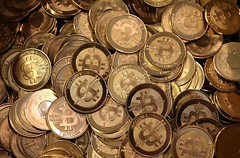 A Norwegian man who purchased $24 worth of bitcoins and then promptly forgot about it for four years, was able to buy an apartment in central Oslo thanks to the massive appreciation of the virtual currency.
A Norwegian man who purchased $24 worth of bitcoins and then promptly forgot about it for four years, was able to buy an apartment in central Oslo thanks to the massive appreciation of the virtual currency.
In 2009, Kristoffer Koch was doing research on encryption and on a whim decided to invest a small sum in the recently created bitcoins -- a means of payment over the Internet.
Koch, now 29 and working as an engineer, only remembered the investment in April of this year when he read an article about the soaring value of bitcoins.
His 5,000 bitcoins were suddenly worth around $690,000 (500,000 euros).
After spending a full day trying to remember his password, Koch cashed in 1.1 million kroner (135,000 euro, $186,000), by selling a fifth of his newly acquired fortune.
After deducting 28 percent in taxes, the money was enough for the downpayment and restoration of a flat worth 2.6 million kroner in central Oslo, one of the world's most expensive cities.
"Not in my wildest dreams could I have imagined that they would have soared like this," Koch said.
"It's bizarre, these psychological reflexes that make us attach a value to something that doesn't have any in itself."
To read the complete article, see: Norwegian man buys flat with forgotten $24 bitcoin investment (news.yahoo.com/norwegian-man-buys-flat-forgotten-24-bitcoin-investment-174651722.html)
ANNIE OAKLEY'S CHARM BRACELET
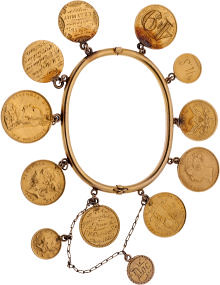 It consists of hinged gold pipes (about 1/8" in diameter) with a spring-blade clasp and safety chain. The inside circumference is 7". From the wrist band and chain hang twelve gold charms. But they are not just charms. Each is a gold coin: one British gold sovereign (c. 7/8" dia.); four British gold half-sovereigns (c. 3/4" dia.); four U.S. five-dollar gold coins (c. 3/4" dia.); and three U.S. $2½ gold coins (c. 1/2" dia.). The oldest coins are an 1873 $5 gold piece and an 1873 half-sovereign; the newest is the sovereign which was first issued in this style in 1887. As charms, they date from 1885 to 1892.
It consists of hinged gold pipes (about 1/8" in diameter) with a spring-blade clasp and safety chain. The inside circumference is 7". From the wrist band and chain hang twelve gold charms. But they are not just charms. Each is a gold coin: one British gold sovereign (c. 7/8" dia.); four British gold half-sovereigns (c. 3/4" dia.); four U.S. five-dollar gold coins (c. 3/4" dia.); and three U.S. $2½ gold coins (c. 1/2" dia.). The oldest coins are an 1873 $5 gold piece and an 1873 half-sovereign; the newest is the sovereign which was first issued in this style in 1887. As charms, they date from 1885 to 1892.
The earliest charm (the 1873 gold coin) was presented to Annie in 1885 by the U.S. Cartridge Company. The others are from friends and family (e.g. Ed and Emily), Wild West companions (e.g. "C. G.", possibly George Crager, Sioux interpreter), from competitive shooters ("Doc" Carver; New Jersey sportsmen Morford, Baldwin, Brockton, and Steele), from admirers (e.g., Henri Journu, Secretary General of France in 1892; and "Miss Mary Blaine"), from Frank, naturally, from Nate Salsbury, and from W. F. "Buffalo Bill" Cody with his initials engraved in imitation of his familiar script, "WFC."
This is not a piece of jewelry that Annie would wear every day, but we now know that she donned it for special occasions. A previous photograph in this auction (Lot 44027) shows her with the treasured charm bracelet on her left wrist. The occasion? The 1919 Valentine's Day Ball at Pinehurst. She danced with the governor of North Carolina that evening and was awarded the prize for best costume.
How precious was the charm bracelet to her? By 1919, the first charms were nearly thirty-five years old; the newest had been given to her twenty-seven years before. During 1917 and 1918 Annie had melted down almost all of her silver and gold medals, cups, and trinkets to buy Liberty Bonds, setting a public example of support for the war effort. So apparently it was not the intrinsic value of the gold (about 1.35 troy ounces) that made her continue to treasure it. The bracelet meant too much to her to part with for several reasons. It provided a sentimental attachment to significant events; it was an emblem of loyalty to the memory of Buffalo Bill and the others; and, it was a beautiful piece of jewelry, tasteful, understated, elegant, and perfectly suited to her sense of herself.
To read the complete lot description, see: Annie Oakley: Her Stunning and Elegant Charm Bracelet!. (historical.ha.com/c/item.zx?saleNo=6110&lotIdNo=41001)
FEATURED WEB SITE: SILVER INGOT BLOG
This week's Featured Web Site is Ken Conaway's Silver Ingots blog, "A blog for collectors of silver ingots, old pours and extruded bars."Ken writes:
I am a routine reader of The E-Sylum and thoroughly enjoy it! I'm not quite a coin collector anymore - I moved some years ago to silver ingots, cast, poured and extruded. I began with a 5 oz hallmark collection and then moved into government mint and assay ingots which have become my passion. While my focus is on 5 oz class government ingots, I have digressed into some larger examples over the years and am finishing a paper addressing the authentication of Type II San Francisco ingots.
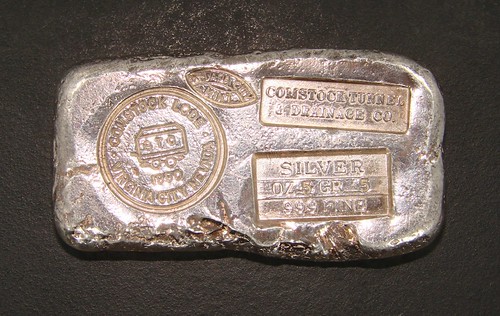
silveringot.blogspot.com
